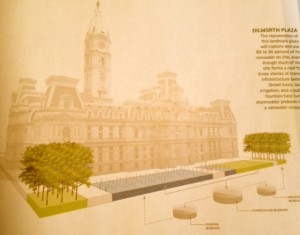
Dilworth Plaza, the plaza in front of Philadelphia City Hall, is being converted into a green site as part of the city’s Green City, Clean Waters program.
A Report from Greenbuild 2013
This year is a transformational one for USGBC. It’s its 20th Anniversary and LEED v4 was just launched at the Green build Convention this week in Philadelphia. LEED v4 is undeniably the most change the green world has seen in this rating system since it was launched in 2000. A more rigorous approach to science and a more vigorous approach to health underlie the changes. This is the 6th Greenbuild I’ve attended and for me, the most comprehensive since I’m not speaking and I am able to participate in everything from educational sessions to keynote to the Expo. This is the first of several reports on this year’s Greenbuild.
A Green City
Greenbuild is in Philadelphia this year and I must say every time I come to Philadelphia I am more impressed and enjoy it more. The city itself is going through its own green transformation, having just passed a benchmarking law similar to New York City’s and taking on really difficult infrastructure changes. There is one specific project I’ve walked by every day while at Greenbuild which I think sets the framework for an innovative way to positively impact your city.

Dilworth Plaza at Philadelphia City Hall is being remade with green infrastructure to mitigate the city’s combined sewer problem. Image courtesy Greensource Magazine.
Philadelphia has one of the oldest combined sewer systems in the country. And for those who don’t know, combined sewer systems are no longer desirable. To upgrade it and separate it out would cost in the range of $10 billion. Instead, the city launched the Green City, Clean Waters program launched in 2011 which commits the city to a 25-year “remaking” program. Instead of building an entirely new city sewer system they are retrofitting 10,000 acres of targeted locations with green infrastructure as a main approach to managing the sewage overflows. This mimics the natural hydrocycle – instead of piping water off the surface, new green infrastructure catches the rainwater, uses it for irrigation, prevents erosion, and reduces flow of pollutants into adjacent waterways.
The prime example of this is Dilworth Plaza in front of City Hall. Rejuvenation of this previously bleak plaza is focusing on water capture – the new infrastructure will capture and use 80 to 90 percent of its rainwater on site, even though much of the site forms a roof for 3 stories of transit infrastructure below. Street trees, lawn irrigation and a public fountain form the core of the new plaza. The interactive fountain will use thin columns of mist to trace the paths of the trains and will become a public skating rink in winter. Philadelphia City Hall is one of the key buildings in Center City and rethinking this crucial urban plaza to become a cultural, social and healthy destination represents the significance of the city’s new thinking. (This section is condensed from an article in this month’s Greensource magazine)
A Green Breakfast

Site plan of the new green infrastructure features for the remaking of Dilworth Plaza. Image courtesy of Greensource magazine.
This year I attended the “Women in Green Power Breakfast.” Usually I stay away from anything with “woman” in the title (see my previous blog “Just Don’t Call Me A Woman Architect”), but I was encouraged to attend by several friends who went to the inaugural one last year and were pleasantly surprised. This was nothing like the AIA Woman events I’ve previously attended. It was sold out, it was full of energy, leadership and ambition and it was filled with women/people who CARE about saving the world and aren’t scared to say why and how.
The topic was “health” and healthy buildings and the morning was divided into discussion at your own table followed by a panel of thought leaders from places as diverse as Bank of America, Interface and USGBC. The women at my table were as impressive as the women on the stage – Director of Sustainability for the City of Philadelphia, Director of Sustainability for George Mason University, Director of Sustainability at the International Monetary Fund, a Director for the HQE rating system in Paris, and an emerging professional from the interior design graduate program at the Corcoran. We all had a lot to say about what makes buildings healthy, particularly how people experience environments differently according to gender and nationality.
Hillary Rodham Clinton is the convention’s keynote speaker. She’s famous for saying “It takes a village” and one of our speakers started out by saying “We are the village!”
And if you’d like to “subscribe” or follow my blog, True Green Cities, please sign up through the “Subscribe” button at the bottom left of this page. You’ll receive a daily recap when new blogs are posted. Or Sign up for the Feed.
